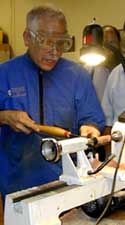


Question:
I've been turning for several years and do fairly well with bowls. Candlesticks, however, are a different story. Once I've settled on a design, the first one goes well. Matching the second one to the first one is excruciating! I use calipers and parting tools to get the heights on the contours, but they never come out quite right.
I've tried leaving both pieces on the lathe without separating them and have also tried finishing one and using it as master. Neither method seems to work very well. After a lot of fussing I find myself giving up and going with "good enough".
I don't believe I turn enough to justify a duplicating attachment...
Do you have any suggestions for turning duplicate pieces?
A.P., Morton, IL
Answer:
Free hand duplication is tough. Like anything, the more you do it, the better you get. I admire those rare individuals who can crank out piece after piece by eye. I am not one of those lucky enough to have that skill. Here is what I would do to make duplicates a few at a time.
Draw or trace the finished project on paper (use graph paper if needed), and include a centerline on the drawing. Then use spray mount adhesive to apply the paper to thin, stiff paperboard or cardboard (posterboard). Use an X-acto or utility knife to cut down the centerline of the pattern and then cut off the profiles to make a negative image of the piece, thus creating a template. The template you made has the exact negative profile of the turning you are making. You can then hold this up to the wood to mark out the dimensions along the length of the candlestick, and use the template as you turn to check your progress. You can also write measurement references on the template to help you dimension the different areas of the turning to the sizes they need to be. The negative template is easier to reference than a finished turning. And since you now have a master template, every turning you create will be fairly close to one another in appearance and size.
If you want a more permanent template, you can make one from thin luan. This is obviously more difficult to cut out than stiff cardboard, but provides a more long-lasting template than posterboard.
Barry Ekins of Auckland, New Zealand has a few candlestick and gavel templates on his
website
that serve as excellent examples (and nice projects).
Download a printable .pdf of the templates.
FOLLOWUP FROM CUSTOMER:
I tried the template method you suggested with a pair of candlesticks. I cut out the profile and made lines to the edge and notes of the high and low dimensions on it. Then I sprayed the edge of the poster board I was using with black paint to better contrast with the maple I was going to turn...
I penciled on the high and low lines on the two pieces of maple I had rounded while they were turning, and then I used a sharp parting tool and calipers to get the diameters fairly close (a tad oversize). I also rigged up a support so that I could reference the template while turning to the profiles. (I have to confess that I used a small, sharp scraper as much as gouges.) Some sandpapering while turning, and NOT BAD !!!
Thanks to you this was the most painless (and closest) duplicating I've ever done. They made a very nice gift.
A.P.